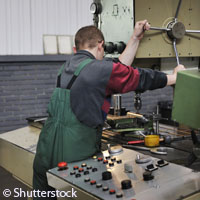EU-funded research helping out the European manufacturing industry
An EU-funded project that will help the European manufacturing industry face up to the challenges facing it is currently underway. Since it kicked off in 2009, researchers working on the 'Self-Learning Control of Tool Temperature in Cutting Processes' (ConTemp) project, which was given a EUR 2,374,976 boost under the NMP ('Nanosciences, nanotechnologies, materials and new production technologies') Theme of the Seventh Framework Programme (FP7), have been developing self-learning adaptive process controls to stabilise machining conditions. 'Increasingly complex production tasks - especially the manufacturing of modern high performance materials - require new tool systems with process-oriented adaptive control systems. For these purposes the ConTemp project provides a technology with a closed inner cooled tool system for the European manufacturing industry,' comments Timo Reinicke, a research engineer from the Institute for Machine Tools and Factory Management at the Technische Universität Berlin, the coordinating institution of the 10 project partners. An increasing number of newly developed and increasingly difficult to machine materials, such as high-temperature alloys and composites, have created new challenges for the cutting technology industry, which despite their high hardness put the tools under high thermal strain. Coupled with the challenge of reducing production costs and times while retaining product quality, these problems require the industry to develop new, innovative machining concepts that move forward what is currently used. Current process monitoring systems concentrate on the monitoring of forces, vibrations and acoustic emissions as input signals, but do not consider tool temperature. The team from Berlin and their consortium partners are now moving research forward to focus on tool temperature as it does have a significant influence on workpiece quality and tool wear and in turn on manufacturing productivity. Controlled and stabilised tool temperatures can lead to longer tool lifetimes and increased part accuracies. Conventional cooling methods are also counter productive to environmental concerns and sustainability. As well as improving part accuracies and productivity, the self-learning adaptive process control will enable the cutting of a larger range of materials to be more economical by minimising tool wear. Developing a new generation of high-performance intelligent and environmentally friendly cutting tools means a reduction of machining times and costs through a decrease in manufacturing times. The pan-European team of researchers hope that by improving these parameters beyond the state of the art, developments on the classic dry machining process will be made. Another feature of the consortium's research is the grounds they are making swapping traditional lubrication processes for a dry machine approach. Through ConTemp the application of cooling lubricant is avoided by a closed internal cooling system. Through this dry machining approach the high costs for the provision and disposal of the cooling lubricant are drastically reduced and environmental damage is also minimised - a huge leap towards sustainable manufacturing. This innovation could reduce production costs by about 20 %, and with effective cooling it may become possible to keep the tool in a safe temperature range to enable the application of diamond coatings in the machining of ferrous materials (materials that contain a lot of iron). Currently the application of diamond tools in machining of ferrous materials is limited to polycrystalline diamond (PCD) inserts for finishing operations. Furthermore, in conventional processes with cooling lubricants, the temperature difference between the hot chips and the cooling lubricant leads to wear on the cutting edge of the tool caused by micro-cracks. This thermal shock damage is avoided by the internally cooled system and thus tool life and part accuracy are increased. As well as being a move towards environmentally friendly machining, cutting out cooling lubricant will mean significant cost reductions can be made.For more information, please visit: Technische Universitat Berlin: http://www.tu-berlin.de/menue/home/parameter/en/(opens in new window) ConTemp Consortium: http://www.contemp.org/(opens in new window)
Countries
Switzerland, Germany, Italy, United Kingdom



